A Fault Tolerant Surveillance System for Fire Detection and Prevention Using LoRaWAN in Smart Buildings
Abstract
1. Introduction
- We propose a fault-tolerant surveillance system for fire detection and prevention in smart buildings exploiting LoRaWAN to reduce latency and enhance reliability;
- Using Wi-Fi LORA 32 sensors and board, we designed and developed a system that can detect smoke, natural gas, LPG, propane, methane, hydrogen, alcohol, temperature, and humidity to prevent fires caused by them;
- We performed extensive experiments over a distance up to 600 m long and up to 2 m high from the ground. The proposed system is tested over 50 packets of varying (16–64) bytes payloads sent/received;
- The performance evaluation is based on the Received Signal Strength Indicator (RSSI), network delay, and response time parameters;
- We demonstrated that LoRaWAN technology is ideal for deploying fire detection and prevention systems in large smart structures and successfully transmitting detected data.
2. Related Work
3. Background of LPWAN and LoRa
4. Problem Statement
5. Research Design and Methods
5.1. Sensing Data Acquisition and Sensor Selection
5.2. Wi-Fi Lora 32 Board
5.3. Dataflow Model for Data Reading and Transmission
5.4. Real-Time Testing
5.4.1. Response Time
5.4.2. Network Delay
6. Performance Evaluation
6.1. Data Gathering
6.2. Data Analytics and Measurement Circumstances
6.2.1. Response Time Measurements in Open Area
- Response Time Analysis
- B.
- Network Delay Analysis
6.2.2. Response Time Measurements in Closed Area
6.2.3. Network Delay Analysis for Closed Area
7. Conclusions and Recommendation
Author Contributions
Funding
Institutional Review Board Statement
Informed Consent Statement
Data Availability Statement
Acknowledgments
Conflicts of Interest
References
- Shafique, K.; Khawaja, B.A.; Sabir, F.; Qazi, S.; Mustaqim, M. Internet of things (IoT) for next-generation smart systems: A review of current challenges, future trends and prospects for emerging 5G-IoT Scenarios. IEEE Access 2020, 8, 23022–23040. [Google Scholar] [CrossRef]
- Berte, D.-R. Defining the IoT. Proc. Int. Conf. Bus. Excell. 2018, 12, 118–128. [Google Scholar] [CrossRef]
- Zhang, Z.K.; Cho, M.C.Y.; Wang, C.W.; Hsu, C.W.; Chen, C.K.; Shieh, S. IoT security: Ongoing challenges and research opportunities. In Proceedings of the 2014 IEEE 7th International Conference on Service-Oriented Computing and Applications, Matsue, Japan, 17–19 November 2014; pp. 230–234. [Google Scholar] [CrossRef]
- Djouani, R.; Djouani, K.; Boutekkouk, F.; Sahbi, R. A Security Proposal for IoT integrated with SDN and Cloud. In Proceedings of the 2018 6th International Conference on Wireless Networks and Mobile Communications (WINCOM), Marrakesh, Morocco, 16–19 October 2018; pp. 1–5. [Google Scholar] [CrossRef]
- Froytlog, A.; Haglund, M.A.; Cenkeramaddi, L.R.; Jordbru, T.; Kjellby, R.A.; Beferull-Lozano, B. Design and implementation of a long-range low-power wake-up radio for IoT devices. In Proceedings of the 2019 IEEE 5th World Forum on Internet of Things (WF-IoT), Limerick, Ireland, 15–18 April 2019; pp. 247–250. [Google Scholar] [CrossRef]
- Adame, T.; Bel, A.; Bellalta, B. Increasing LPWAN Scalability by Means of Concurrent Multiband IoT Technologies: An Industry 4.0 Use Case. IEEE Access 2019, 7, 46990–47010. [Google Scholar] [CrossRef]
- Vega-Rodriguez, R.; Sendra, S.; Lloret, J.; Romero-Diaz, P.; Luis Garcia-Navas, J. Low cost LoRa based network for forest fire detection. In Proceedings of the 2019 Sixth International Conference on Internet of Things: Systems, Management and Security (IOTSMS), Granada, Spain, 22–25 October 2019; pp. 177–184. [Google Scholar] [CrossRef]
- Deve, K.B.; Hancke, G.P.; Silva, B.J. Design of a smart fire detection system. In Proceedings of the IECON 2016—42nd Annual Conference of the IEEE Industrial Electronics Society, Florence, Italy, 23–26 October 2016; pp. 6205–6210. [Google Scholar] [CrossRef]
- Al Mojamed, M. Smart mina: Lorawan technology for smart fire detection application for hajj pilgrimage. Comput. Syst. Sci. Eng. 2022, 40, 259–272. [Google Scholar] [CrossRef]
- Wang, Y.P.E.; Lin, X.; Adhikary, A.; Grövlen, A.; Sui, Y.; Blankenship, Y.; Bergman, J.; Razaghi, H.S. A Primer on 3GPP Narrowband Internet of Things. IEEE Commun. Mag. 2017, 55, 117–123. [Google Scholar] [CrossRef]
- Kufakunesu, R.; Hancke, G.P.; Abu-Mahfouz, A.M. A survey on adaptive data rate optimization in lorawan: Recent solutions and major challenges. Sensors 2020, 20, 5044. [Google Scholar] [CrossRef] [PubMed]
- Zourmand, A.; Hing, A.L.K.; Hung, C.W.; Abdulrehman, M. Internet of Things (IoT) using LoRa technology. In Proceedings of the 2019 IEEE International Conference on Automatic Control and Intelligent Systems (I2CACIS), Selangor, Malaysia, 29 June 2019; pp. 324–330. [Google Scholar] [CrossRef]
- Farhad, A.; Kim, D.H.; Subedi, S.; Pyun, J.Y. Enhanced lorawan adaptive data rate for mobile Internet of things devices. Sensors 2020, 20, 6466. [Google Scholar] [CrossRef] [PubMed]
- Mekki, K.; Bajic, E.; Chaxel, F.; Meyer, F. A comparative study of LPWAN technologies for large-scale IoT deployment. ICT Express 2019, 5, 1–7. [Google Scholar] [CrossRef]
- Dong, W.H.; Wang, L.; Yu, G.Z.; Mei, Z. Bin Design of Wireless Automatic Fire Alarm System. Procedia Eng. 2016, 135, 413–417. [Google Scholar] [CrossRef][Green Version]
- Liu, Y.; Qi, M. The design of building fire monitoring system based on ZigBee-WiFi Networks. In Proceedings of the 2016 Eighth International Conference on Measuring Technology and Mechatronics Automation (ICMTMA), Macau, China, 11–12 March 2016; pp. 733–735. [Google Scholar] [CrossRef]
- Saputra, F.A.; Al Rasyid, M.U.H.; Abiantoro, B.A. Prototype of early fire detection system for home monitoring based on Wireless Sensor Network. In Proceedings of the 2017 International Electronics Symposium on Engineering Technology and Applications (IES-ETA), Surabaya, Indonesia, 26–27 September 2017; pp. 39–44. [Google Scholar] [CrossRef]
- Alkhatib, A.A.A. Sub-network coverage method as an efficient method of wireless sensor networks for forest fire detection. In Proceedings of the International Conference on Internet of things and Cloud Computing, Cambridge, UK, 22–23 March 2016. [Google Scholar] [CrossRef]
- Haxhibeqiri, J.; Karaagac, A.; Van Den Abeele, F.; Joseph, W.; Moerman, I.; Hoebeke, J. LoRa indoor coverage and performance in an industrial environment: Case study. In Proceedings of the 2017 22nd IEEE International Conference on Emerging Technologies and Factory Automation (ETFA), Limassol, Cyprus, 12–15 September 2017; pp. 1–8. [Google Scholar] [CrossRef]
- Sendra, S.; García, L.; Lloret, J.; Bosch, I.; Vega-Rodríguez, R. LoRaWAN network for fire monitoring in rural environments. Electronics 2020, 9, 531. [Google Scholar] [CrossRef]
- Neumann, P.; Montavont, J.; Noel, T. Indoor deployment of low-power wide area networks (LPWAN): A LoRaWAN case study. In Proceedings of the 2016 IEEE 12th International Conference on Wireless and Mobile Computing, Networking and Communications (WiMob), New York, NY, USA, 17–19 October 2016. [Google Scholar] [CrossRef]
- Naik, N. LPWAN technologies for IoT systems: Choice between Ultra narrow band and spread spectrum. In Proceedings of the 2018 IEEE International Systems Engineering Symposium (ISSE), Rome, Italy, 1–3 October 2018. [Google Scholar]
- Gaddam, S.C.; Rai, M.K. A comparative study on various LPWAN and cellular communication technologies for IoT based smart applications. In Proceedings of the 2018 International Conference on Emerging Trends and Innovations in Engineering and Technological Research (ICETIETR), Ernakulam, India, 11–13 July 2018; pp. 1–8. [Google Scholar] [CrossRef]
- Masood, S.H.; Riza, S. Trends in Selective Laser Sintering in Biomedical Engineering. Int. J. Emerg. Trends Eng. Res. 2020, 8, 8–11. Available online: http://www.warse.org/IJETER/static/pdf/file/ijeter10812020.pdf (accessed on 18 August 2022).
- Iqbal, M.; Abdullah, A.Y.M.; Shabnam, F. An application based comparative study of LPWAN technologies for IoT environment. In Proceedings of the 2020 IEEE Region 10 Symposium (TENSYMP), Dhaka, Bangladesh, 5–7 June 2020; pp. 1857–1860. [Google Scholar] [CrossRef]
- Matni, N.; Moraes, J.; Oliveira, H.; Rosário, D.; Cerqueira, E. Lorawan gateway placement model for dynamic Internet of things scenarios. Sensors 2020, 20, 4336. [Google Scholar] [CrossRef] [PubMed]
- Roque, G.; Padilla, V.S. LPWAN based IoT surveillance system for outdoor fire detection. IEEE Access 2020, 8, 114900–114909. [Google Scholar] [CrossRef]
- Son, B.; Her, Y.; Kim, J. A design and implementation of forest-fires surveillance system based on wireless sensor networks for South Korea mountains. Int. J. Comput. Sci. Netw. Secur. 2006, 6, 124–130. [Google Scholar]
- Kanakaraja, P.; Sairamnadipalli, L.S.P.; Aswinkumer, S.V.; Ganesh, N.; Lekha, U.C.; Irfan, S.K. Industrial Parameters Monitoring With Lora Technology in Next Generation Wireless Communications. Turkish J. Physiother. Rehabil. 2021, 32, 805–815. [Google Scholar]
- Verba, N.; Chao, K.; Lewandowski, J.; Shah, N. Modelling Industry 4.0 based Fog Computing environments for Application analysis and deployment. Futur. Gener. Comput. Syst. 2018, 91, 48–60. [Google Scholar] [CrossRef]
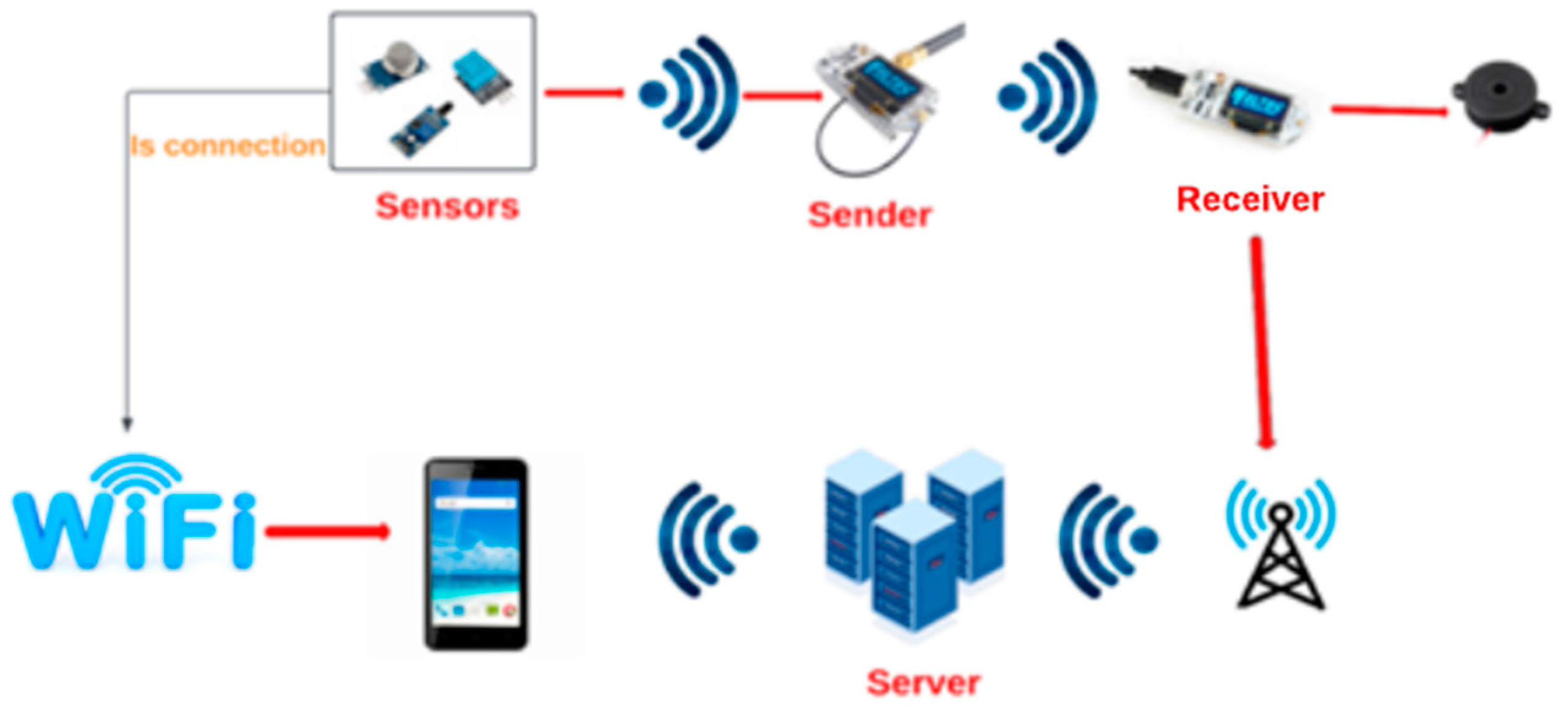
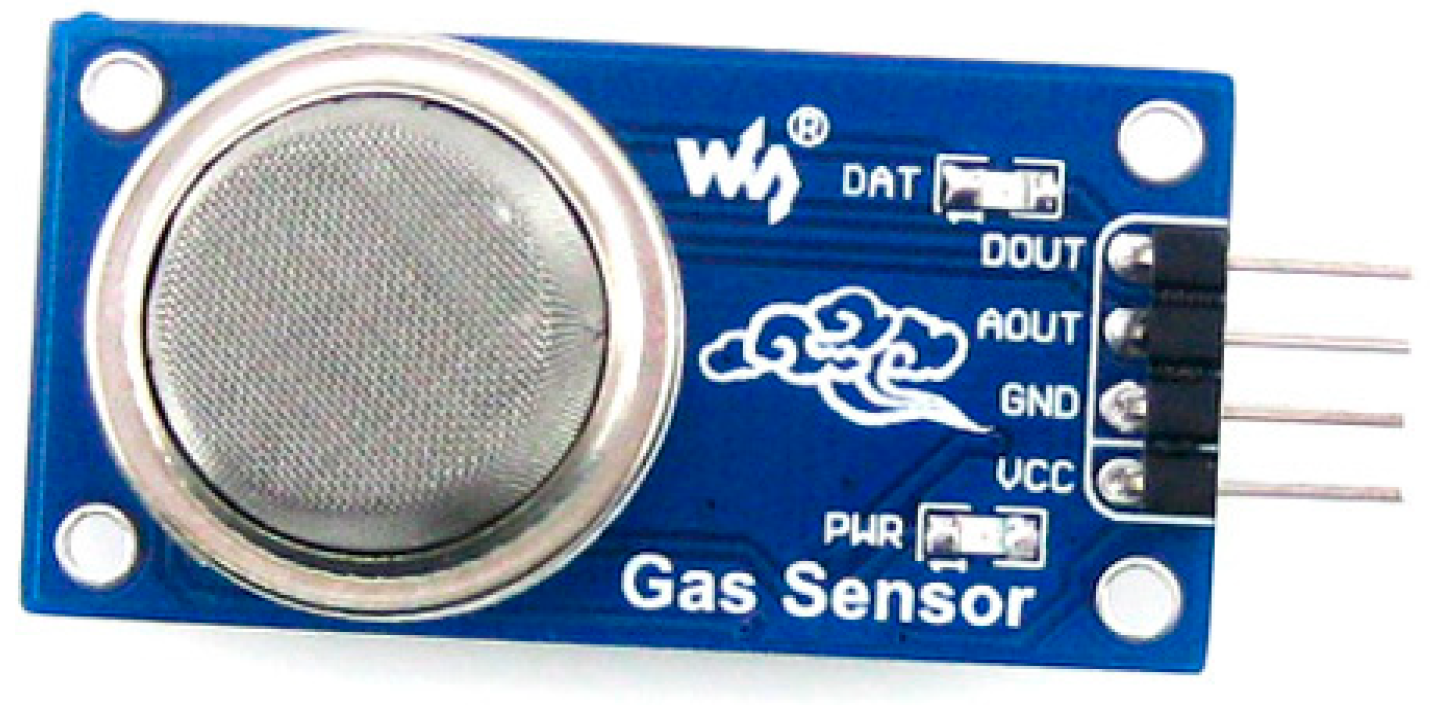
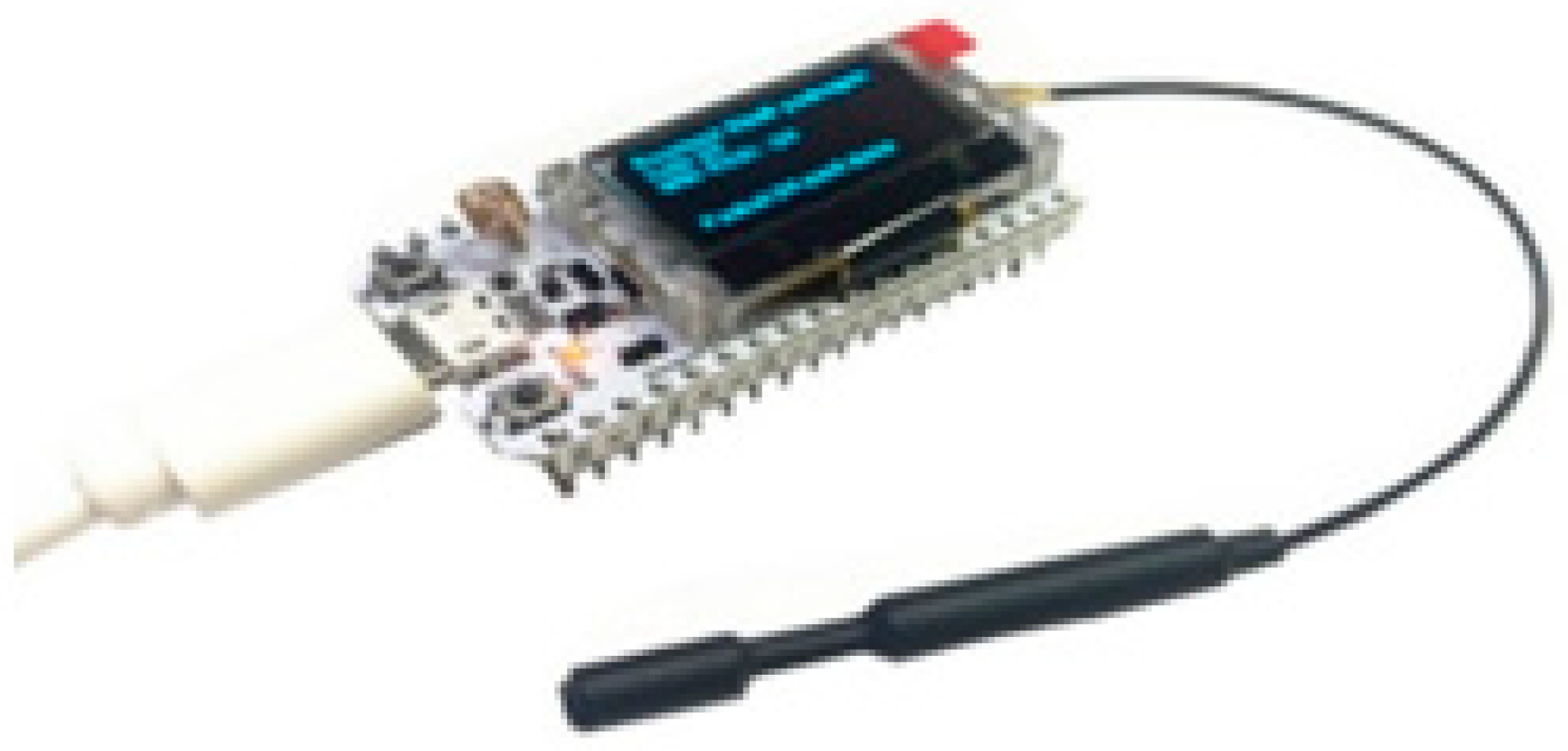
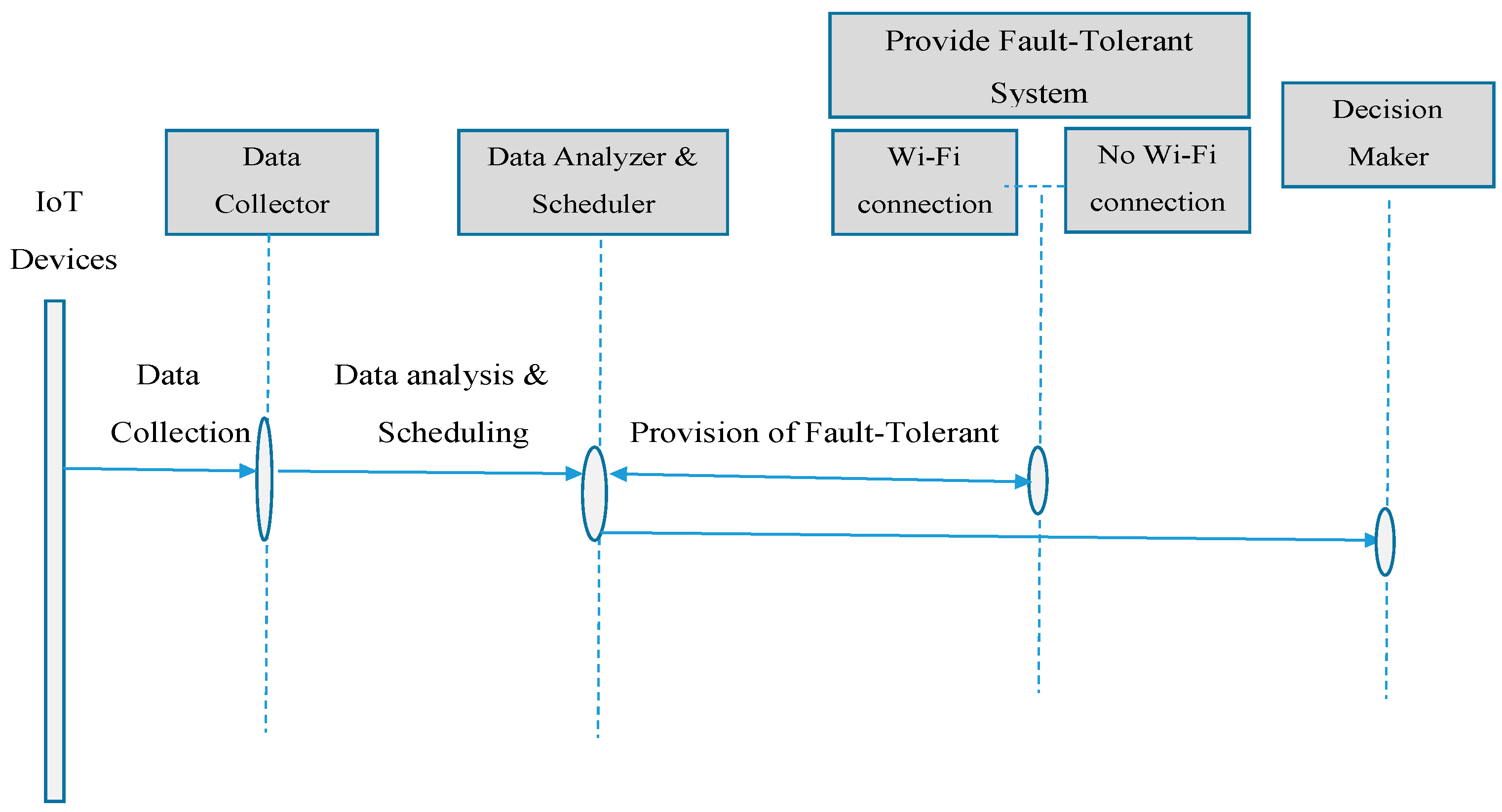
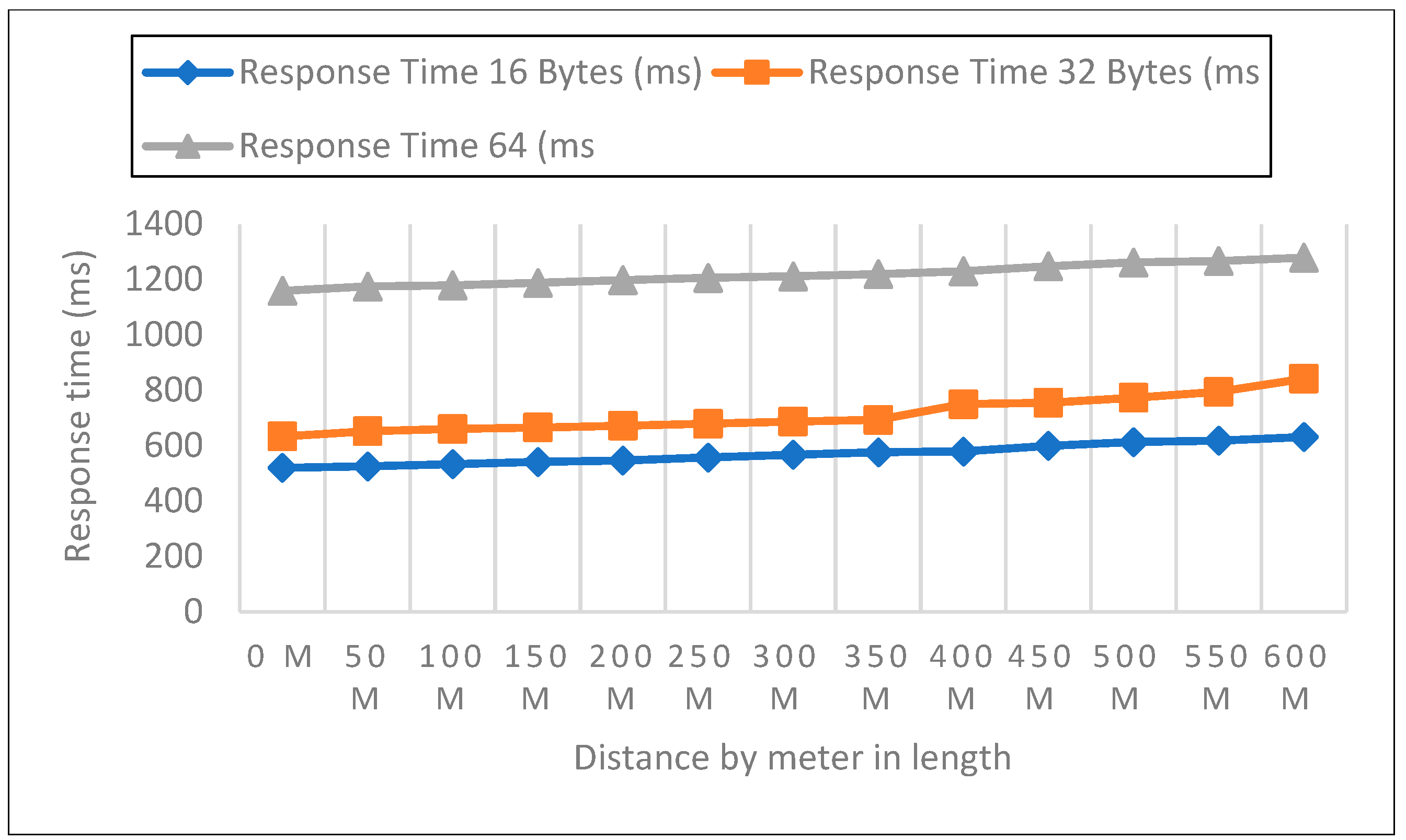
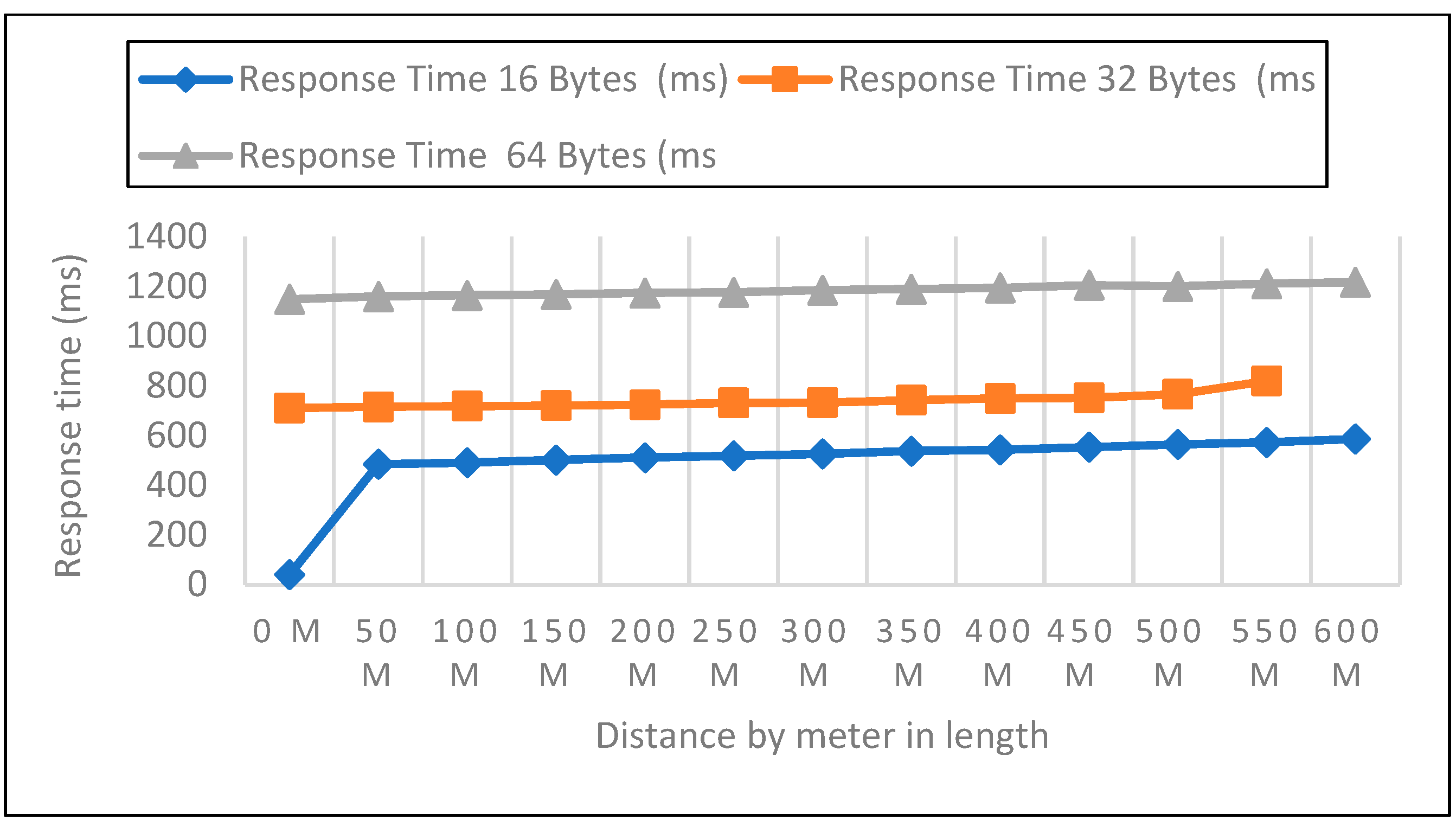
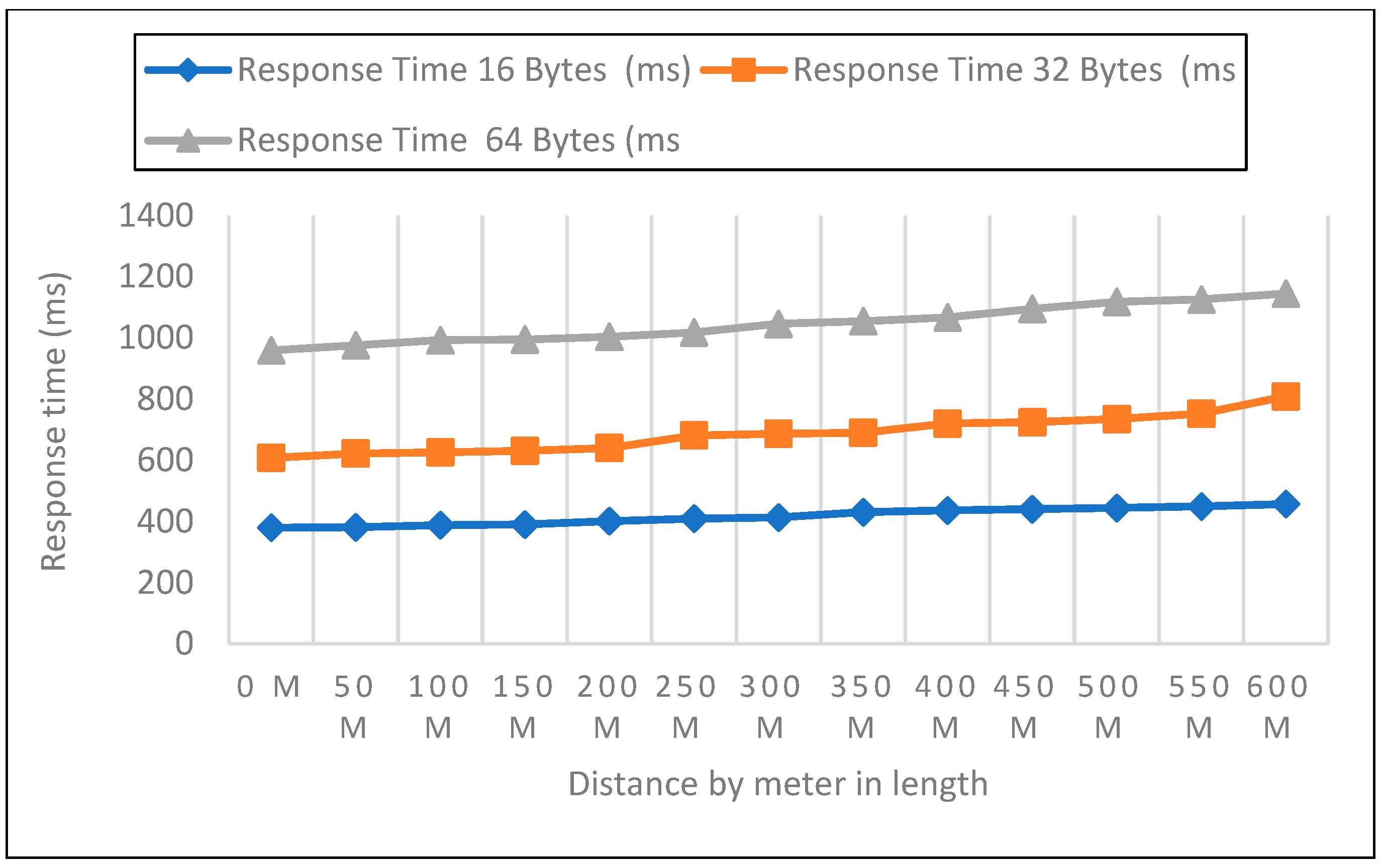
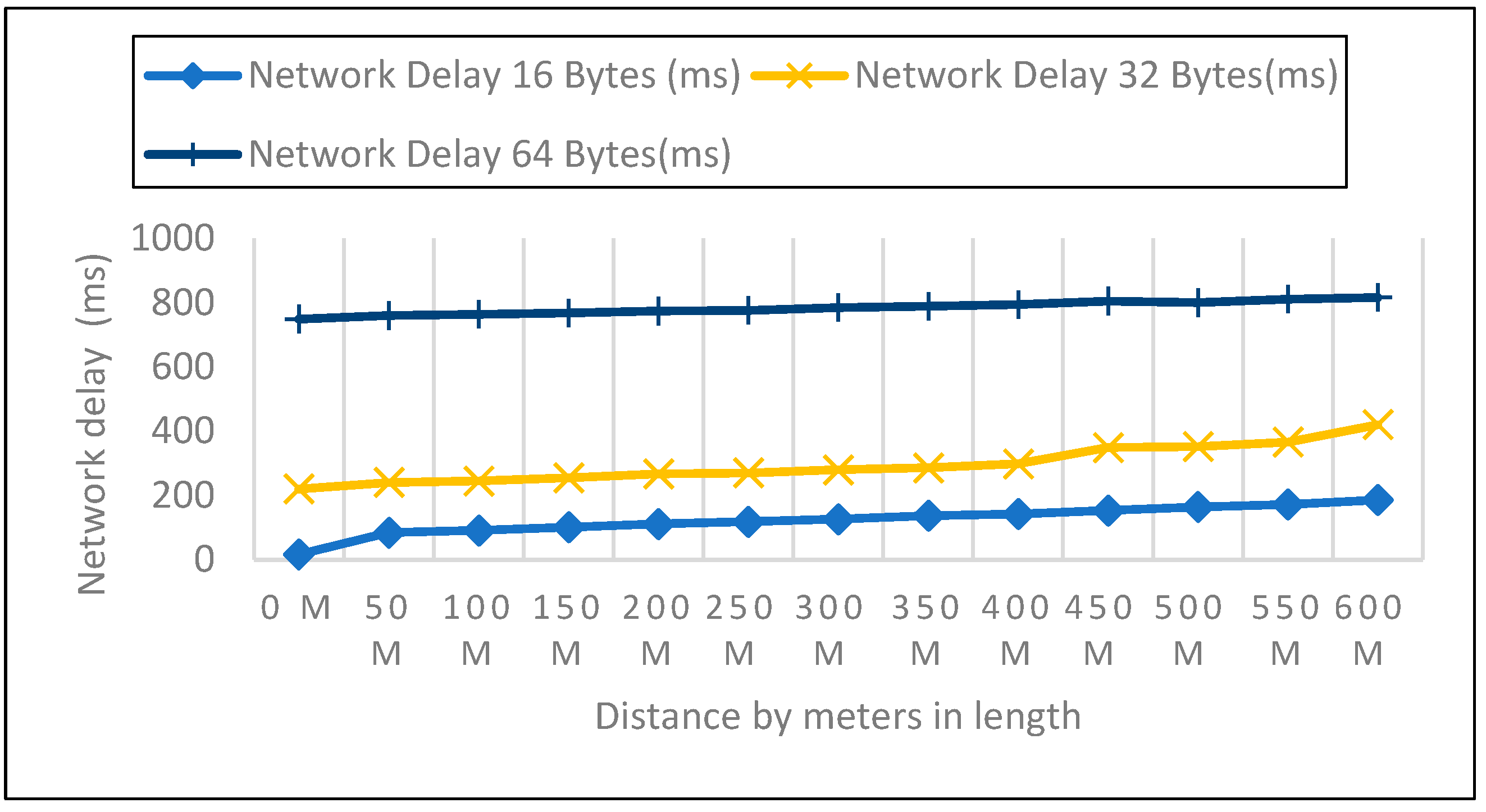
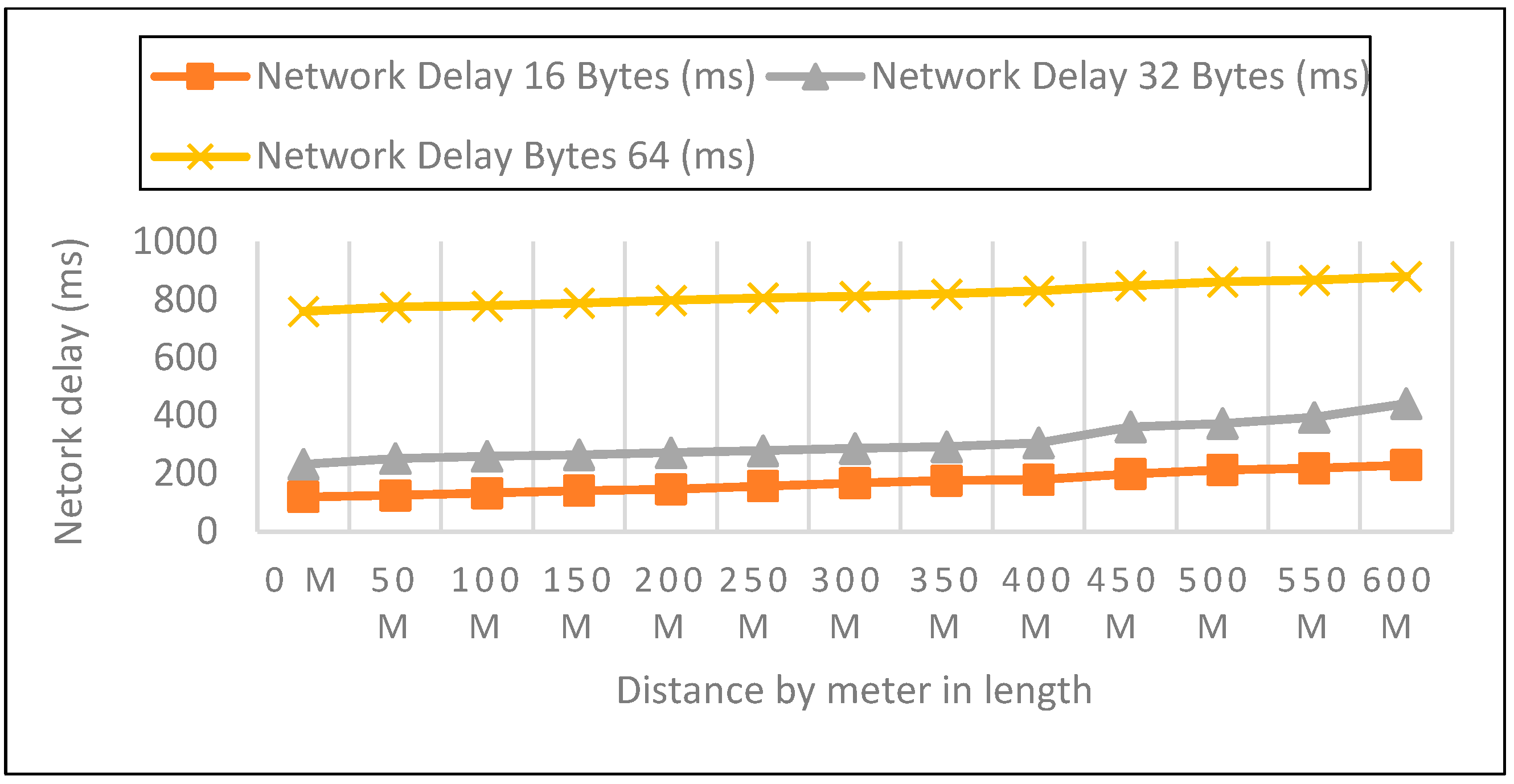
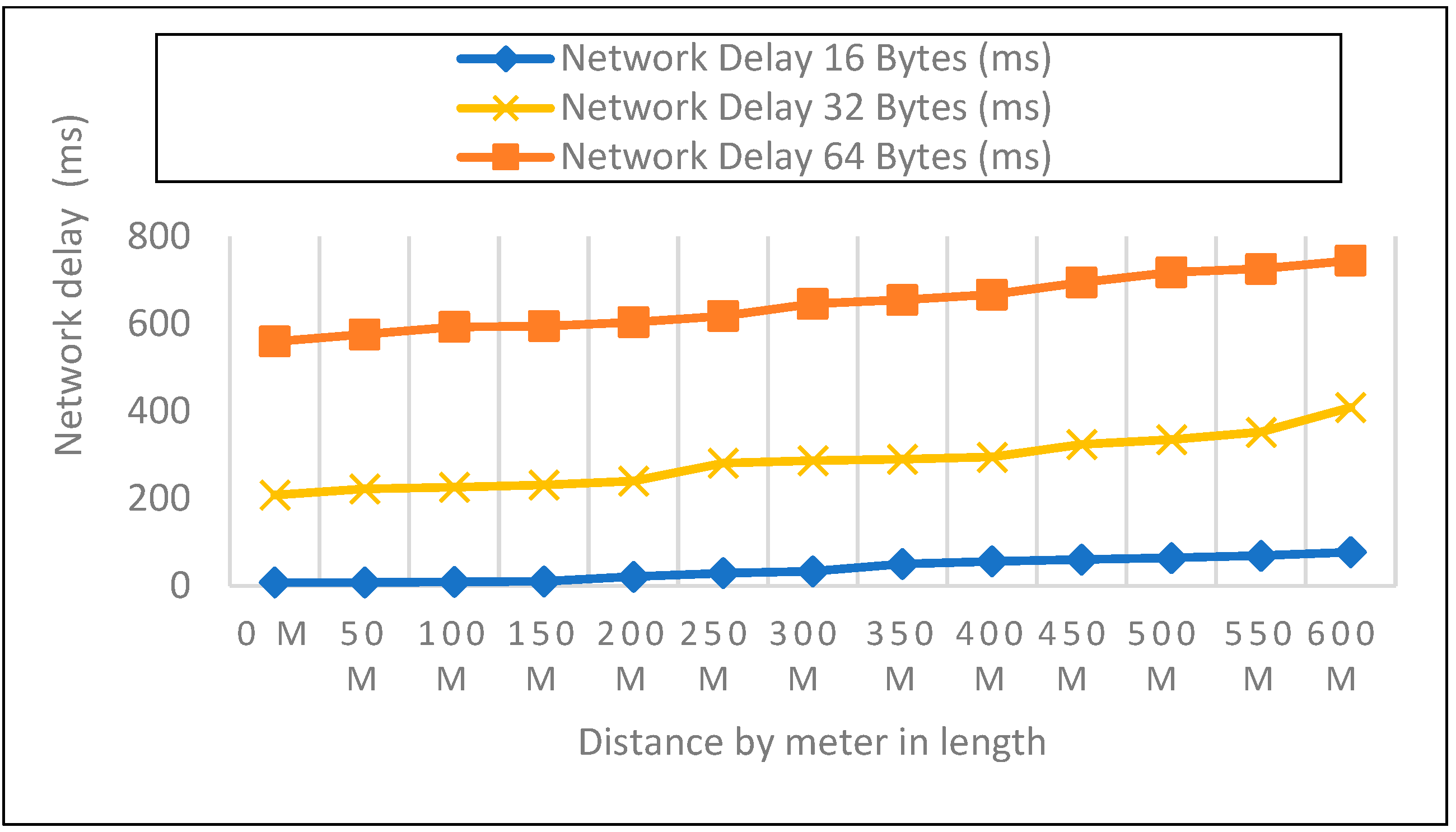
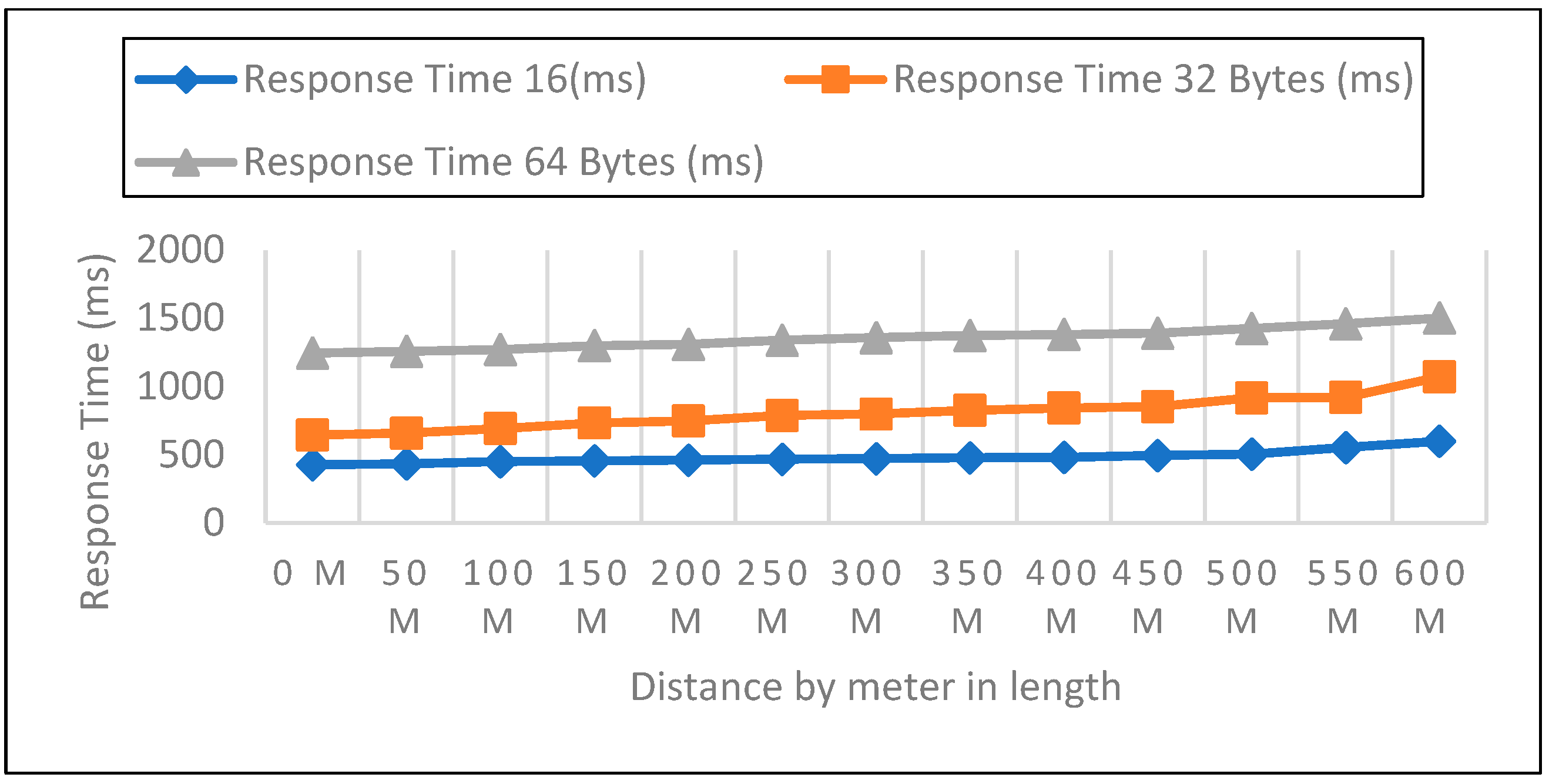
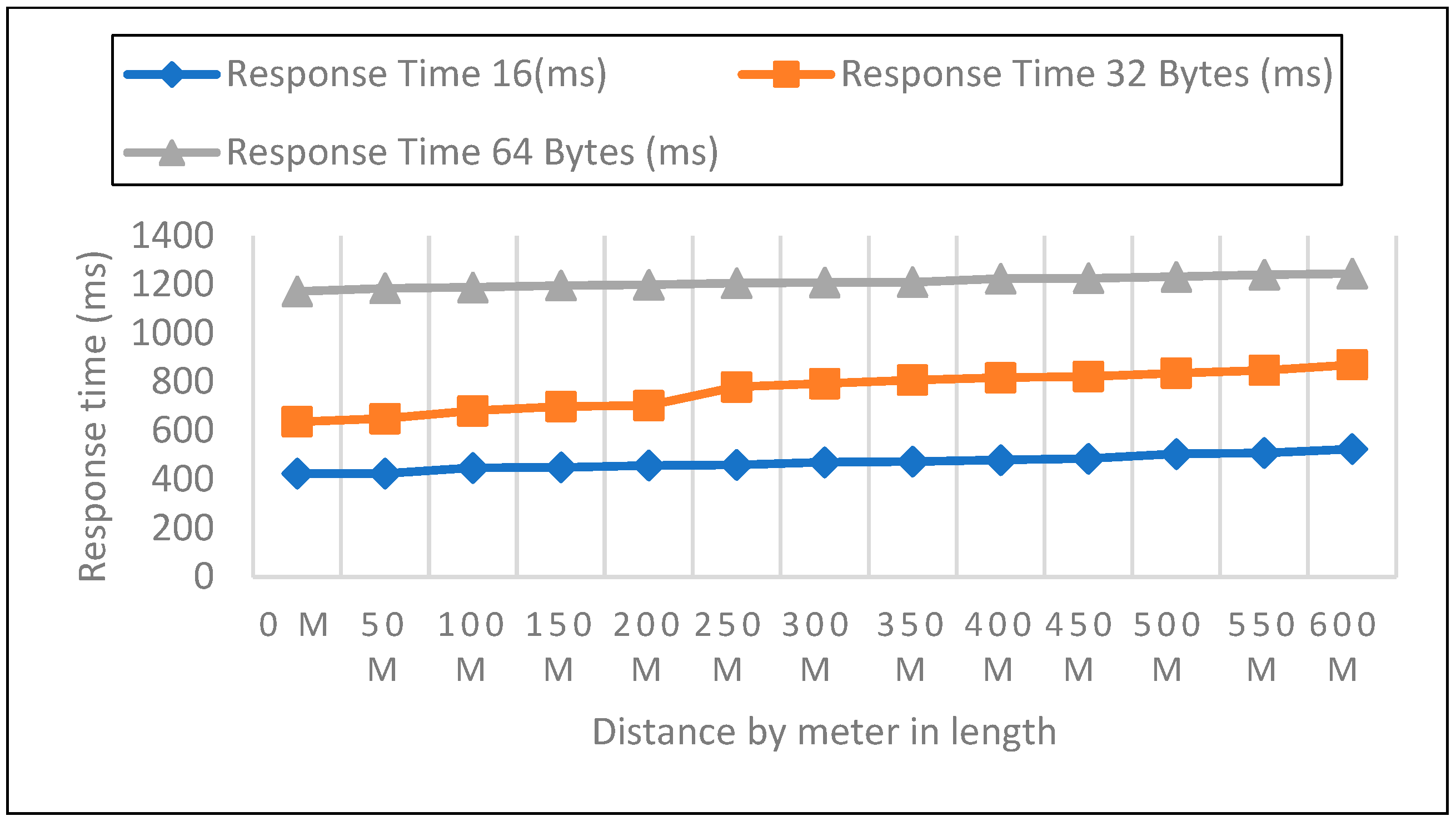
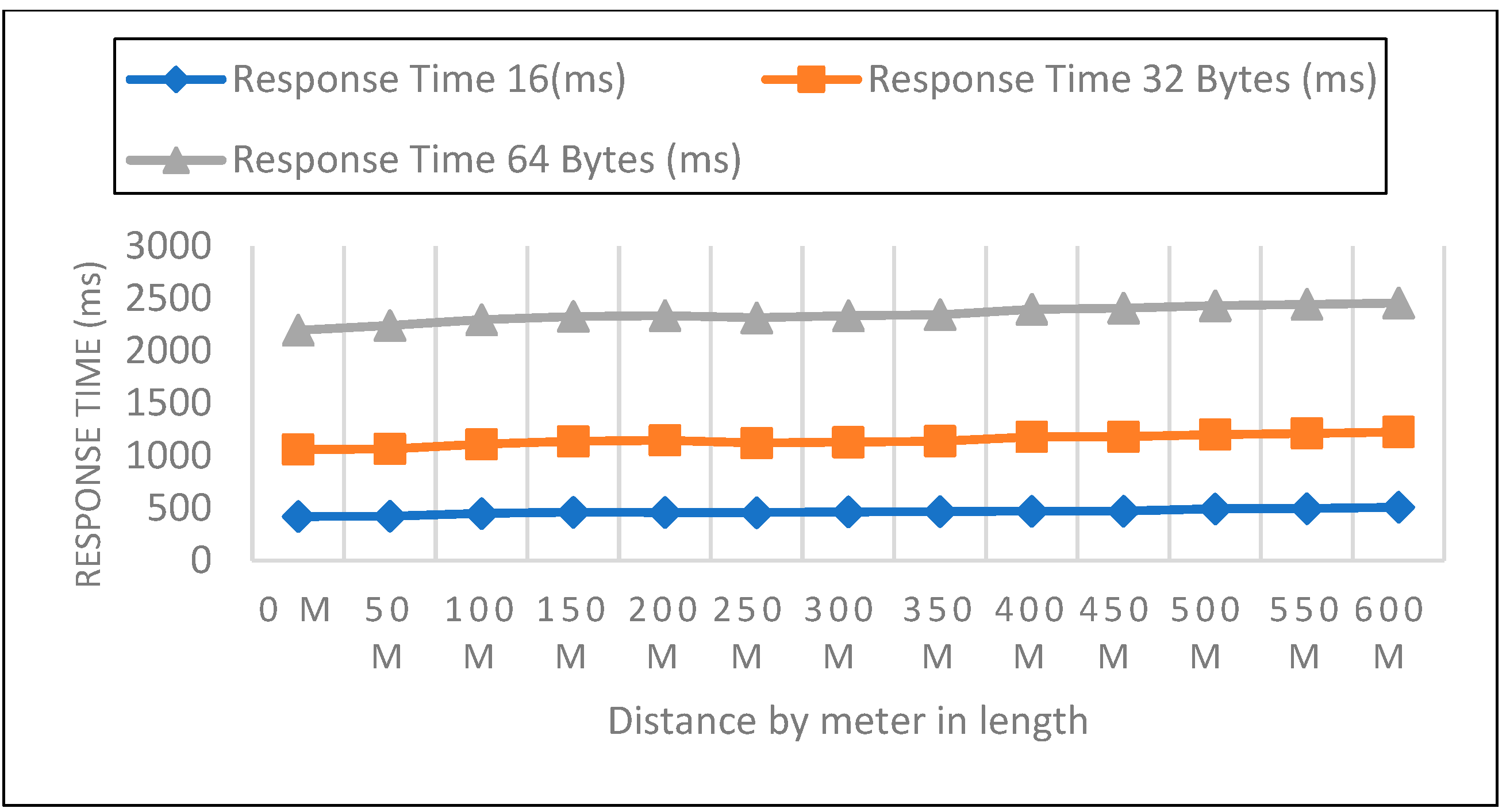
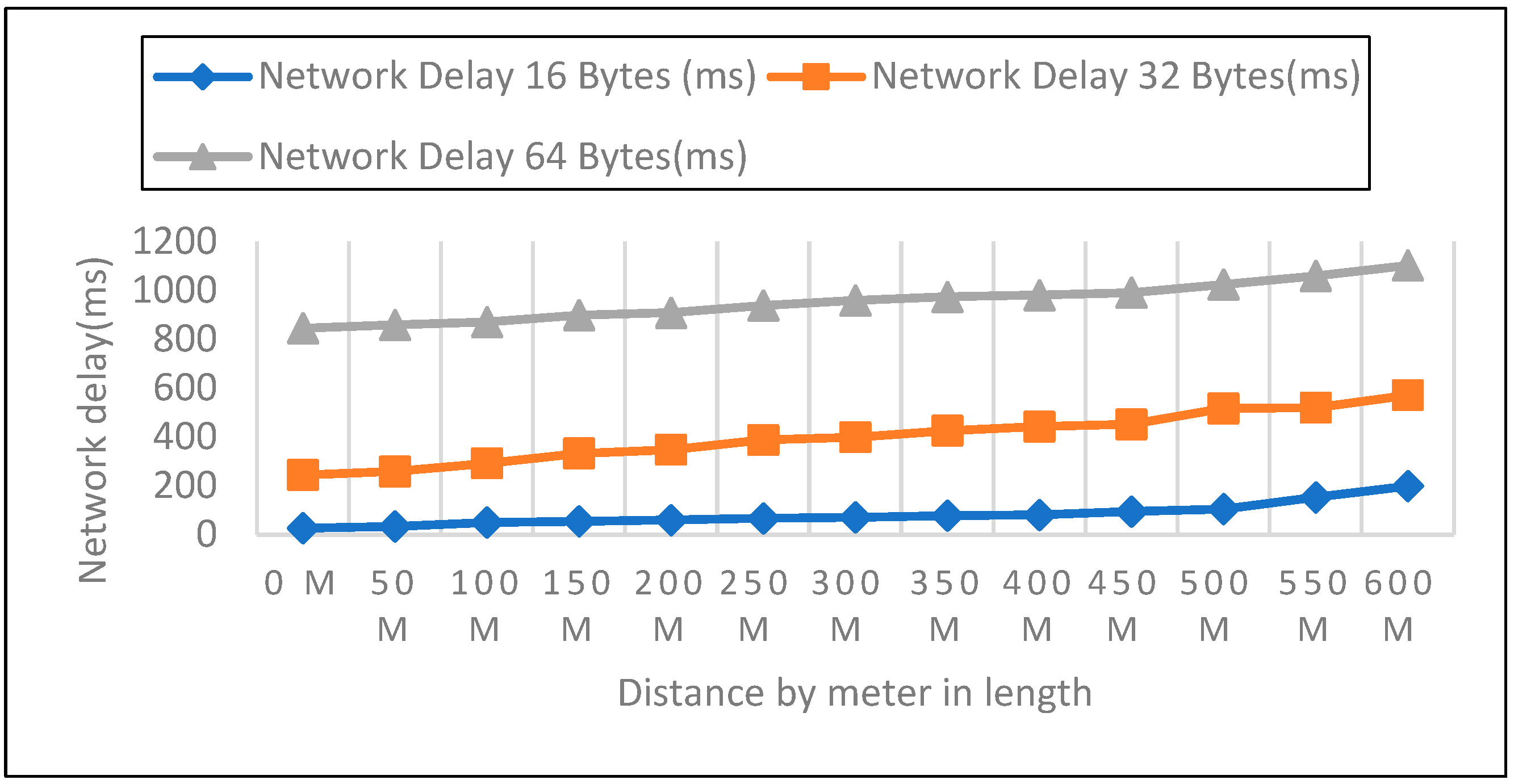
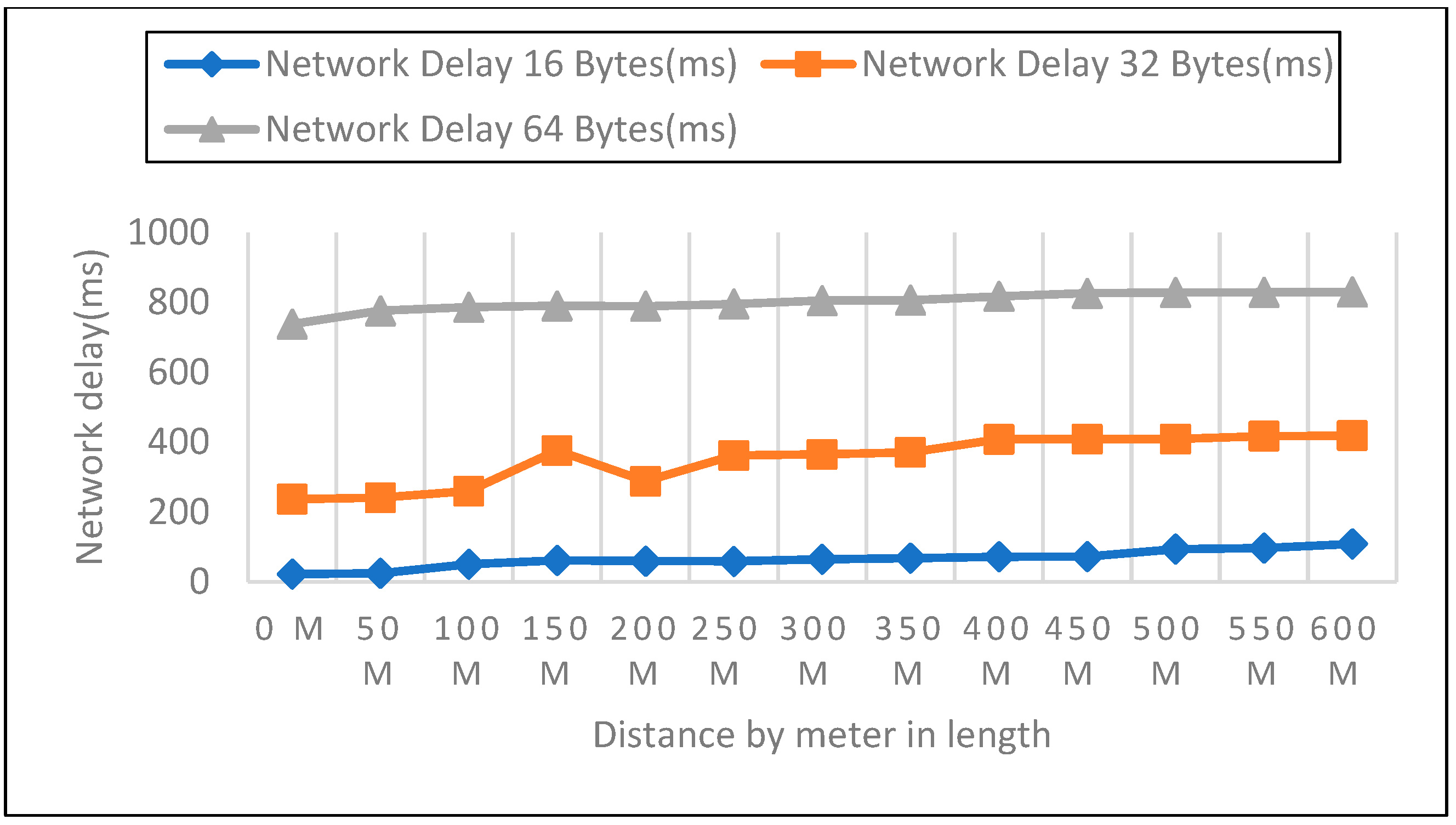

| Authors and Year | Environment | Technology | Contributions | Limitations |
|---|---|---|---|---|
| Roberto Vega-Rodríguez et al. [7], 2019 | Low-Cost LoRa-Based Forest Fire Detection Network | LoRa | The system is composed of a LoRa node and a set of sensors. | Less Receiver sensitivity indoors and in smart buildings. |
| M. Al Mojamed [9], 2022 | Smart mina: LoRaWAN technology for smart fire detection | LoRa | Simulated a Flora model in OMNET++. Considered the packet delivery ratio and collisions. | Not a real-world fault-tolerant framework. |
| K. c et al. [10], 2017 | Design and implementation of the mobile Fire Alarm System (FAS) | Wi-Fi | The Android Studio-coded Arduino implantation. | Lack of an internet connection renders the machine inoperable. |
| W. H. Dong et al. [15], 2016 | Design of Wireless Automatic FAS | Wi-Fi | To achieve rapid energy-efficient fire detection, alarm, and governmental oversight of fire-fighting infrastructure. | The system did not identify flames. No authentication system detects false alerts. |
| Y. Liu and M et al. [12], 2016 | Fire Monitoring System-Based ZigBee-Wi-Fi Networks | ZigBee-Wi-Fi Networks | Monitoring the fire alarm remotely, aiding in evacuation. | Model cannot connect to all fire-affected devices, and the monitor is not connected to a central server. |
| F. A. Saputra et al. [17], 2017 | Early FDS for Home | Raspberry Pi | Typical monitoring of fire alarms. | Involves higher power consumption. |
| Ahmad Alkhatib et al. [18], 2016 | Forest fire detection WSN system | Zigbee | Proposed a scalable system with three sub-networks. | Power hungry and no-fault tolerance. |
| Sendra et al. [20], 2020 | fire risk assessment system based on LoRaWAN technology | LoRaWAN | The LoRa node has humidity, temperature, CO2, and wind speed sensors. | End node distribution and coverage are not defined. |
| Size | 16 Bytes | 32 Bytes | 64 Bytes | |||||||||||||||
|---|---|---|---|---|---|---|---|---|---|---|---|---|---|---|---|---|---|---|
| Height | 0 M | 1 M | 2 M | 0 M | 1 M | 2 M | 0 M | 1 M | 2 M | |||||||||
| Distance | R-T | RSSI | R-T | RSSI | R-T | RSSI | R-T | RSSI | R-T | RSSI | R-T | RSSI | R-T | RSSI | R-T | RSSI | R-T | RSSI |
| 0 | 520 | −22 | 40 | −41.3 | 380 | −48.16 | 633 | −27.42 | 620 | −24.88 | 608 | −42 | 1160 | −35.18 | 1149 | −56.6 | 960 | −55 |
| 50 | 525 | −80.98 | 484 | −99.06 | 381 | −85.86 | 652 | −92.82 | 640 | −78.82 | 622 | −84 | 1175 | −99.8 | 1160 | −76.86 | 976 | −77.1 |
| 100 | 533 | −92.3 | 491 | −108 | 388 | −86.58 | 660 | −99.24 | 645 | −89.82 | 626 | −96.48 | 1179 | −104.54 | 1164 | −91 | 993 | −86.72 |
| 150 | 541 | −91.6 | 501 | −109.8 | 390 | −89.8 | 665 | −94.84 | 655 | −86.32 | 631 | −92.8 | 1188 | −92.48 | 1168 | −93.52 | 995 | −90.66 |
| 200 | 546 | −107 | 511 | −110.42 | 401 | −103 | 672 | −99.98 | 720 | −92.52 | 640 | −92.42 | 1198 | −102 | 1174 | −86.44 | 1004 | −94.96 |
| 250 | 557 | −103 | 518 | −112.84 | 409 | −104.54 | 679 | −111.62 | 675 | −97.5 | 681 | −106.66 | 1206 | −106.34 | 1176 | −104.32 | 1018 | −105.74 |
| 300 | 567 | −109 | 526 | −117.28 | 413 | −113.38 | 687 | −111.64 | 680 | −100.66 | 687 | −111.18 | 1212 | −121.92 | 1185 | −107.9 | 1046 | −106.54 |
| 350 | 576 | −115 | 537 | −124.26 | 430 | −113.96 | 693 | −114 | 686 | −108.38 | 690 | −115.88 | 1220 | −120.2 | 1189 | −115.72 | 1055 | −114.72 |
| 400 | 579 | −118 | 542 | −127 | 436 | −117.48 | 706 | −116.6 | 698 | −106.28 | 695 | −112.88 | 1230 | −127.42 | 1194 | −118.14 | 1067 | −121.16 |
| 450 | 599 | −116 | 553 | −124.1 | 440 | −118.2 | 730 | −115.66 | 749 | −111.86 | 724 | −117.72 | 1248 | −131 | 1205 | −118.8 | 1095 | −111.42 |
| 500 | 613 | −123 | 564 | −128.76 | 444 | −114.24 | 773 | −11.66 | 752 | −111.18 | 735 | −115.18 | 1262 | −120.7 | 1200 | −127.8 | 1118 | −112.32 |
| 550 | 618 | −121 | 572 | −129.12 | 449 | −118.46 | 794 | −113 | 766 | −120 | 752 | −114.8 | 1267 | −121.5 | 1211 | −121.48 | 1126 | −111.52 |
| 600 | 631 | −131 | 586 | −130.66 | 457 | −116.86 | 842 | −123 | 820 | −128.52 | 809 | −124.28 | 1280 | −135.6 | 1217 | −128.78 | 1145 | −117.82 |
| Size | 16 Bytes | 32 Bytes | 64 Bytes | |||||||||||||||
|---|---|---|---|---|---|---|---|---|---|---|---|---|---|---|---|---|---|---|
| Height | 0 M | 1 M | 2 M | 0 M | 1 M | 2 M | 0 M | 1 M | 2 M | |||||||||
| Distance | N-D | RSSI | N-D | RSSI | N-D | RSSI | N-D | RSSI | N-D | RSSI | N-D | RSSI | N-D | RSSI | N-D | RSSI | N-D | RSSI |
| 0 | 120 | −22 | 16 | −41.3 | 8 | −48.2 | 233 | −27.4 | 220 | −24.9 | 208 | −42 | 760 | −35.2 | 749 | −56.6 | 560 | −55 |
| 50 | 125 | −80.98 | 84 | −99.06 | 8 | −85.86 | 252 | −92.82 | 240 | −78.82 | 222 | −84 | 775 | −99.8 | 760 | −76.86 | 576 | −77.1 |
| 100 | 133 | −92.3 | 91 | −108 | 9 | −86.6 | 260 | −99.24 | 245 | −89.9 | 226 | −96.5 | 779 | −105 | 764 | −91 | 593 | −86.7 |
| 150 | 141 | −95.6 | 101 | −110 | 10 | −89.8 | 265 | −94.8 | 255 | −86.3 | 231 | −92.8 | 788 | −92.5 | 768 | −93.52 | 595 | −90.7 |
| 200 | 146 | −107 | 111 | −110 | 21 | −103 | 272 | −100 | 267 | −92.5 | 240 | −92.4 | 798 | −102 | 774 | −86.44 | 604 | −95 |
| 250 | 157 | −103 | 118 | −113 | 29 | −105 | 279 | −100 | 270 | −97.5 | 281 | −107 | 806 | −106.34 | 776 | −104.32 | 618 | −106 |
| 300 | 167 | −109 | 126 | −117 | 33 | −113 | 287 | −112 | 280 | −101 | 287 | −111 | 812 | −122 | 785 | −107.9 | 646 | −107 |
| 350 | 176 | −115 | 137 | −124 | 50 | −114 | 293 | −112 | 286 | −108 | 290 | −116 | 820 | −120 | 789 | −115.72 | 655 | −115 |
| 400 | 179 | −118 | 142 | −127 | 56 | −117 | 306 | −114 | 298 | −107 | 295 | −113 | 830 | −127 | 794 | −118.14 | 667 | −121 |
| 450 | 199 | −116 | 153 | −124 | 60 | −118 | 361 | −116 | 349 | −112 | 324 | −118 | 848 | −131 | 805 | −118.8 | 695 | −111.4 |
| 500 | 213 | −123 | 164 | −129 | 64 | −114 | 373 | −112 | 352 | −111 | 335 | −115 | 862 | −121 | 800 | −127.8 | 718 | −112.3 |
| 550 | 218 | −121 | 172 | −129 | 69 | −118 | 394 | −113 | 366 | −120 | 352 | −115 | 867 | −122 | 811 | −121.84 | 726 | −112 |
| 600 | 230 | −131 | 186 | −131 | 77 | −117 | 442 | −123 | 420 | −128.5 | 409 | −124 | 880 | −136 | 817 | 128.78 | 745 | −118 |
| Size | 16 Bytes | 32 Bytes | 64 Bytes | |||||||||||||||
|---|---|---|---|---|---|---|---|---|---|---|---|---|---|---|---|---|---|---|
| Height | 1 Floor | 2 Floor | 3 Floor | 1 Floor | 2 Floor | 3 Floor | 1 Floor | 2 Floor | 3 Floor | |||||||||
| Distance | R-T | RSSI | R-T | RSSI | R-T | RSSI | R-T | RSSI | R-T | RSSI | R-T | RSSI | R-T | RSSI | R-T | RSSI | R-T | RSSI |
| 0 | 520 | −22 | 40 | −41.3 | 380 | −48.16 | 633 | −27.42 | 620 | −24.88 | 608 | −42 | 1160 | −35.13 | 1149 | −56.6 | 960 | −55 |
| 50 | 525 | −80.98 | 484 | −99.06 | 381 | −85.86 | 652 | −92.82 | 640 | −78.82 | 622 | −84 | 1175 | −99.8 | 1160 | −76.86 | 976 | −77.1 |
| 100 | 533 | −92.3 | 491 | −108 | 388 | −86.58 | 660 | −99.24 | 645 | −89.88 | 626 | −96.48 | 1179 | −104.5 | 1164 | −91 | 993 | −86.72 |
| 150 | 541 | −95.6 | 501 | −109.8 | 390 | −89.8 | 665 | −94.84 | 655 | −86.32 | 631 | −92.8 | 1188 | −92.48 | 1168 | −93.52 | 995 | −90.66 |
| 200 | 546 | −107 | 511 | −110.4 | 401 | −103 | 672 | −99.98 | 720 | −92.52 | 640 | −92.42 | 1198 | −102 | 1174 | −86.44 | 1004 | −94.96 |
| 250 | 557 | −103 | 518 | −112.8 | 409 | −104.5 | 679 | −99.98 | 675 | −97.5 | 681 | −106.7 | 1206 | −106.34 | 1176 | −104.3 | 1018 | −105.7 |
| 300 | 567 | −109 | 526 | −117.3 | 413 | −113.4 | 687 | −111.6 | 680 | −100.7 | 687 | −111.2 | 1212 | −121.9 | 1185 | −107.9 | 1046 | −106.5 |
| 350 | 576 | −115 | 537 | −124.3 | 430 | −114 | 693 | −111.6 | 686 | −108.3 | 690 | −115.9 | 1220 | −120.2 | 1189 | −115.7 | 1055 | −114.7 |
| 400 | 579 | −118 | 542 | −127 | 436 | −117.5 | 706 | −114 | 698 | −106.7 | 695 | −112.9 | 1230 | −127.4 | 1194 | −118.1 | 1067 | −121.2 |
| 450 | 599 | −116 | 553 | −124.1 | 440 | −118.2 | 730 | −115.6 | 749 | −111.9 | 724 | −117.7 | 1248 | −131 | 1205 | −118.8 | 1095 | −111.42 |
| 500 | 613 | −123 | 564 | −128.8 | 444 | −114.2 | 773 | −111.7 | 752 | −111.2 | 735 | −115.2 | 1262 | −120.7 | 1200 | 127.8 | 1118 | −112.32 |
| 550 | 618 | −121 | 572 | −129.1 | 449 | −118.5 | 794 | −113 | 766 | −120 | 752 | −114.8 | 1267 | −121.5 | 1211 | 121.8 | 1126 | −111.5 |
| 600 | 631 | −131 | 586 | −130.7 | 457 | −116.9 | 842 | −123 | 820 | −128.52 | 809 | −124.3 | 1280 | −135.6 | 1217 | −128.8 | 1145 | −117.8 |
| Size | 16 Bytes | 32 Bytes | 64 Bytes | |||||||||||||||
|---|---|---|---|---|---|---|---|---|---|---|---|---|---|---|---|---|---|---|
| Height | 1 Floor | 2 Floor | 3 Floor | 1 Floor | 2 Floor | 3 Floor | 1 Floor | 2 Floor | 3 Floor | |||||||||
| Distance | N-D | RSSI | N-D | RSSI | N-D | RSSI | N-D | RSSI | N-D | RSSI | N-D | RSSI | N-D | RSSI | N-D | RSSI | N-D | RSSI |
| 0 | 26 | −72.3 | 24 | −53.78 | 23 | −14.6 | 244 | −73.2 | 236 | −70.2 | 237 | −30.5 | 845 | −67.2 | 771 | −29.5 | 738 | −40.7 |
| 50 | 33 | −75.35 | 24 | −87.2 | 25 | −79.46 | 258 | −74.66 | 249 | −74.66 | 241 | −81.68 | 858 | −74.88 | 784 | −72.16 | 776 | −85.9 |
| 100 | 49 | −89.1 | 47 | −89.7 | 51 | −97.2 | 291 | −85.7 | 281 | −80.7 | 260 | −90.3 | 870 | −83.5 | 788 | −80.8 | 786 | −90.4 |
| 150 | 54 | −104 | 49 | −115 | 62 | −91.7 | 321 | −93.3 | 299 | −85.3 | 376 | −105 | 898 | −65.6 | 795 | −92.2 | 790 | −97.1 |
| 200 | 59 | −109 | 57 | −119 | 60 | −97 | 347 | −101 | 303 | −101 | 288 | −101 | 908 | −99.6 | 798 | −94.7 | 789 | −94.9 |
| 250 | 66 | −119 | 59 | −119 | 59 | −91 | 387 | −113 | 379 | −113 | 362 | −99.5 | 938 | −103 | 805 | −102 | 795 | −104 |
| 300 | 70 | −116.8 | 70 | −121 | 65 | −107 | 398 | −117 | 393 | −115 | 365 | −105 | 958 | −105 | 808 | −104 | 805 | −102 |
| 350 | 77 | −124 | 73 | 118 | 68 | −102 | 425 | −113 | 491 | −113 | 371 | −111 | 973 | −113 | 809 | −107 | 806 | −110 |
| 400 | 80 | −118 | 79 | −124 | 72 | −112 | 442 | −104 | 417 | −116 | 408 | −107 | 980 | −112 | 823 | −103 | 817 | −118 |
| 450 | 94 | −124 | 85 | −128 | 73 | −119 | 451 | −108 | 422 | −108 | 409 | −117 | 990 | −110 | 825 | −121 | 826 | −119 |
| 500 | 104 | −124 | 104 | −123 | 94 | −119 | 516 | −121 | 436 | −121 | 409 | −119 | 1024 | −119 | 831 | −113 | 828 | −112 |
| 550 | 152 | −131 | 108 | −124 | 97 | −125 | 519 | −126 | 447 | −126 | 417 | −125 | 1059 | −117 | 840 | −118 | 829 | −127 |
| 600 | 198 | 131.1 | 124 | −128 | 109 | −128 | 570 | −115 | 470 | −115 | 419 | −125 | 1102 | −125 | 845 | −113 | 830 | −121 |
Publisher’s Note: MDPI stays neutral with regard to jurisdictional claims in published maps and institutional affiliations. |
© 2022 by the authors. Licensee MDPI, Basel, Switzerland. This article is an open access article distributed under the terms and conditions of the Creative Commons Attribution (CC BY) license (https://creativecommons.org/licenses/by/4.0/).
Share and Cite
Safi, A.; Ahmad, Z.; Jehangiri, A.I.; Latip, R.; Zaman, S.K.u.; Khan, M.A.; Ghoniem, R.M. A Fault Tolerant Surveillance System for Fire Detection and Prevention Using LoRaWAN in Smart Buildings. Sensors 2022, 22, 8411. https://doi.org/10.3390/s22218411
Safi A, Ahmad Z, Jehangiri AI, Latip R, Zaman SKu, Khan MA, Ghoniem RM. A Fault Tolerant Surveillance System for Fire Detection and Prevention Using LoRaWAN in Smart Buildings. Sensors. 2022; 22(21):8411. https://doi.org/10.3390/s22218411
Chicago/Turabian StyleSafi, Abdullah, Zulfiqar Ahmad, Ali Imran Jehangiri, Rohaya Latip, Sardar Khaliq uz Zaman, Muhammad Amir Khan, and Rania M. Ghoniem. 2022. "A Fault Tolerant Surveillance System for Fire Detection and Prevention Using LoRaWAN in Smart Buildings" Sensors 22, no. 21: 8411. https://doi.org/10.3390/s22218411
APA StyleSafi, A., Ahmad, Z., Jehangiri, A. I., Latip, R., Zaman, S. K. u., Khan, M. A., & Ghoniem, R. M. (2022). A Fault Tolerant Surveillance System for Fire Detection and Prevention Using LoRaWAN in Smart Buildings. Sensors, 22(21), 8411. https://doi.org/10.3390/s22218411







